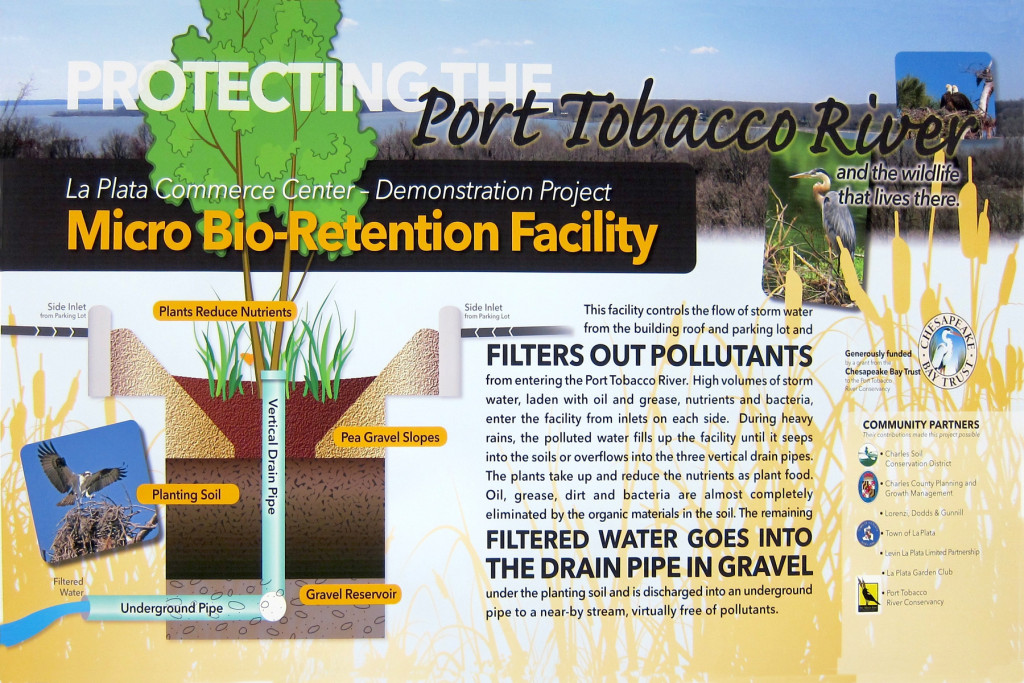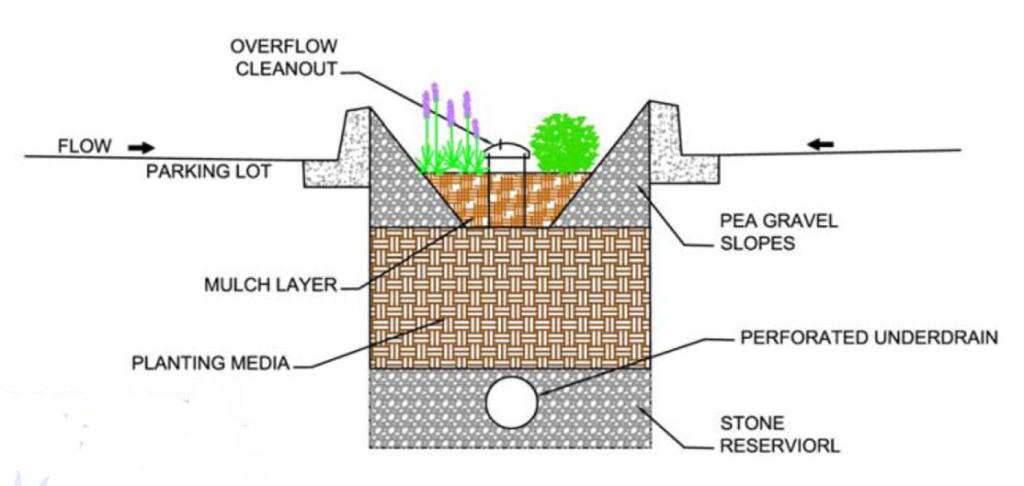 Micro-bioretention Project
Micro-bioretention Project
PTRC was instrumental in the construction of a demonstration storm water system in a parking lot used by two office buildings on Route 301 in La Plata. This project is an example of a stormwater Best Management Practice. The facility slows and cleans polluted storm water runoff before it reaches pipes that carry it directly into the Port Tobacco River. The project is also aimed at educating area students and encouraging other owners of commercial buildings and shopping centers to help clean up the environment while beautifying their properties.
The bioretention retrofit takes up two parking spaces. Storm water is retained in the top two-foot section and gradually filters through two feet of soil planted with native plants (red maples, inkberries and switch grasses). Volume-controlled and filtered water then moves to a nearby stream through a perforated pipe covered in stones, and then to existing underground pipes (see figure below).

PTRC brought together a group of partners to work on the project, including the Chesapeake Bay Trust, which provided $11,769 in grant funds; Charles County Planning & Growth Management and the Charles County Soil Conservation District, which helped plan and obtain landowner approval and support; the La Plata Garden Club, which provided matching funds for design and plants; a local Boy Scout troop, which did the planting; Lorenzi, Dodds & Gunnill who did the engineering design; and Levin La Plata Limited Partnership, who contributed to construction of the retrofit. The town of La Plata waived all permitting fees. The office complex owner provided an in-kind donation to construct the bioretention cell. Professionally designed signage describes the storm water filtration and control process and recognizes our partners’ contributions. We will also use this project to educate students and local businesses and organizations and to encourage environmental stewardship. The project was completed in April 2012.
Charles County’s Watershed Protection and Restoration Fund
Stormwater runoff is generated when precipitation from rain and snowmelt events flows over land or impervious surfaces and does not percolate into the ground. As the runoff flows over the land or impervious surfaces (paved streets, parking lots, and building rooftops), it accumulates debris, chemicals, sediment or other pollutants that could adversely affect water quality if the runoff is discharged untreated. The primary method to control stormwater discharges is the use of best management practices (BMPs).
Source: U.S. Environmental Protection Agency Stormwater Homepage
Residents of Charles County help to address the problems associated with stormwater runoff through their participation in the Watershed Protection and Restoration Program passed by the State of Maryland in 2012. This program created a Stormwater Remediation Fee to pay for stormwater management as well as stream and wetland restoration projects to improve water quality and reduce phosphorus and nitrogen levels entering Chesapeake Bay and its tributaries, including the Port Tobacco River. The Stormwater Remediation Fee is similar to other infrastructure fees many of us are already used to paying – services such as sewer, drinking water, garbage collection and highways.
Charles County is one of approximately 2,000 jurisdictions nationwide that levy the fee to address major flooding and stormwater issues in their communities. In Maryland, the fee is charged in the nine largest counties (Anne Arundel, Baltimore, Carroll, Charles, Frederick, Harford, Howard, Montgomery, and Prince George’s) and Baltimore City.
Charles County’s Bill 2013-11 requires all properties with impervious surface area to pay the fee, the amount of which is set annually by the County Commissioners. For 2015, the fee is $43 per property. The fees are placed in a Watershed Protection and Restoration Fund and may be used for:
- Capital improvements for stormwater management, including stream and wetland restoration projects;
- Operation and maintenance of stormwater management systems and facilities;
- Public education and outreach relating to stormwater management or stream and wetland restoration;
- Stormwater management planning, including mapping and assessment of impervious surfaces, as well as monitoring, inspection and enforcement activities to carry out the purposes of the Watershed Protection and Restoration Fund;
- Reasonable costs necessary to administer the Watershed Protection and Restoration Fund; and
- Grants to nonprofit organizations for project planning, design, and construction of stormwater management practices; stream and wetland restoration; and public education and outreach related to stormwater management or stream and wetland restoration.